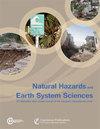通过集合神经网络进行时空滑坡灾害建模
IF 4.2
2区 地球科学
Q1 GEOSCIENCES, MULTIDISCIPLINARY
引用次数: 4
摘要
摘要迄今为止,对滑坡时空动态的全面数值描述只能通过基于物理的模型来实现。地质科学界在开发数据驱动模型时,侧重于通过易感性模型预测滑坡可能发生的位置。此外,他们还通过属于预警系统或降雨阈值类别的模型来估计滑坡可能发生的时间。在这种情况下,已发表的研究成果中很少有探讨时空联合模型结构的。此外,完成灾害定义的第三个要素,即滑坡规模(即面积或体积),几乎从未在空间和时间上建模。然而,数据驱动模型的技术进步已经达到了可以对所有三个要素(位置、频率和大小)进行建模的成熟水平。本研究以此为方向,首次提出了一种评估特定地区滑坡危害的解决方案,即在空间和时间上对滑坡发生率及其每个测绘单位的相关区域密度进行联合建模。为此,我们使用了为受高尔察地震影响的尼泊尔地区生成的时空滑坡数据库。该模型依赖于使用集合神经网络(Ensemble Neural Network)训练的深度学习架构,在该架构中,滑坡发生率和密度被汇总到 1 km × 1 km 的平方测绘单元上,并根据嵌套的 30 m 网格进行分类或回归。在嵌套层次上,我们表达了易发和诱发因素。至于时间单元,我们使用了大约 6 个月的分辨率。我们的模型在整个时空域的易感性(AUC = 0.93)和密度预测(Pearson r = 0.93)任务中的表现都令人满意,因此结果很有希望。该模型与常见的滑坡易感性建模文献有很大不同,它提出了一个在数据驱动背景下进行灾害建模的综合框架。本文章由计算机程序翻译,如有差异,请以英文原文为准。
Space–time landslide hazard modeling via Ensemble Neural Networks
Abstract. Until now, a full numerical description of the spatio-temporal dynamics of a landslide could be achieved only via physically based models. The part of the geoscientific community in developing data-driven models has instead focused on predicting where landslides may occur via susceptibility models. Moreover, they have estimate when landslides may occur via models that belong to the early-warning system or to the rainfall-threshold classes. In this context, few published research works have explored a joint spatio-temporal model structure. Furthermore, the third element completing the hazard definition, i.e., the landslide size (i.e., areas or volumes), has hardly ever been modeled over space and time. However, technological advancements in data-driven models have reached a level of maturity that allows all three components to be modeled (Location, Frequency, and Size). This work takes this direction and proposes for the first time a solution to the assessment of landslide hazard in a given area by jointly modeling landslide occurrences and their associated areal density per mapping unit, in space and time. To achieve this, we used a spatio-temporal landslide database generated for the Nepalese region affected by the Gorkha earthquake. The model relies on a deep-learning architecture trained using an Ensemble Neural Network, where the landslide occurrences and densities are aggregated over a squared mapping unit of 1 km × 1 km and classified or regressed against a nested 30 m lattice. At the nested level, we have expressed predisposing and triggering factors. As for the temporal units, we have used an approximately 6 month resolution. The results are promising as our model performs satisfactorily both in the susceptibility (AUC = 0.93) and density prediction (Pearson r = 0.93) tasks over the entire spatio-temporal domain. This model takes a significant distance from the common landslide susceptibility modeling literature, proposing an integrated framework for hazard modeling in a data-driven context.
求助全文
通过发布文献求助,成功后即可免费获取论文全文。
去求助
来源期刊
CiteScore
7.60
自引率
6.50%
发文量
192
审稿时长
3.8 months
期刊介绍:
Natural Hazards and Earth System Sciences (NHESS) is an interdisciplinary and international journal dedicated to the public discussion and open-access publication of high-quality studies and original research on natural hazards and their consequences. Embracing a holistic Earth system science approach, NHESS serves a wide and diverse community of research scientists, practitioners, and decision makers concerned with detection of natural hazards, monitoring and modelling, vulnerability and risk assessment, and the design and implementation of mitigation and adaptation strategies, including economical, societal, and educational aspects.

 求助内容:
求助内容: 应助结果提醒方式:
应助结果提醒方式:


